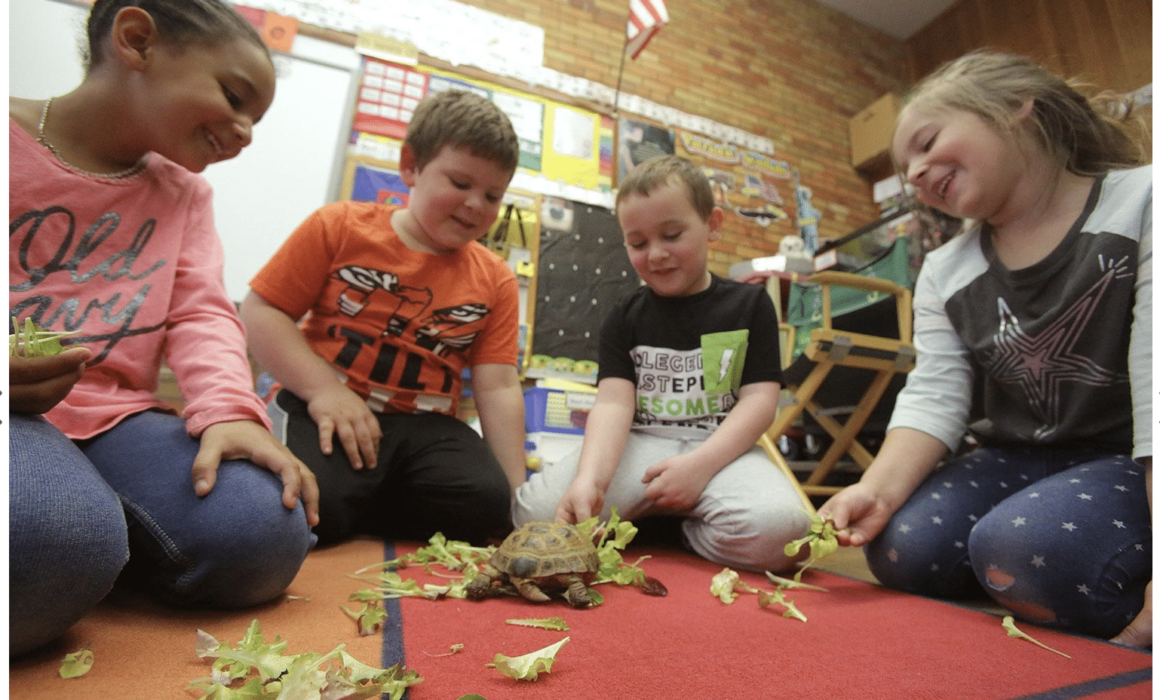Indoor Gardens Teaching Massillon Students New Lessons
The Herbert W. Hoover Foundation is proud to have supported the establishment of the five hydroponic gardens in Massillon City Schools. This story was originally published by the Canton Repository. The original article is available here.
Indoor hydroponic gardens, funded through a grant, have been installed in each of the district’s buildings.
MASSILLON The excitement in Karen Kortis’ kindergarten class builds as the class tortoise is taken from his enclosure and placed on the floor.
Students gather around to give their reptile friend a bite to eat.
What’s for lunch? Romaine lettuce grown by the students in their classroom at Whittier Elementary School.
Across the Massillon City Schools’ buildings, students are planting, growing and learning about vegetables.
The district received five hydroponic gardens for each of the district’s schools through a grant from the Herbert W. Hoover Foundation.
The grant provided $22,250 worth of supplies, including the indoor gardens, growing supplies such as seeds and soil for three years, training and educational lessons.
The district learned about the gardens through Katie Phibbs, co-owners of Lettuce Do Good, an indoor gardening and STEM education company that brings hydroponics into schools.
Blair said Phibbs approached other Stark County schools.
“I thought it was so cool,” she said. “The pictures were amazing. Gardening is not something that a lot of kids get a chance to experience anymore.”
Blair knew the indoor gardens would be a great learning tool for students.
“They get to learn the science behind it, harvest it and actually eat it,” Blair said. ”
The gardens have even widened students’ — and teachers’ — palates.
Growing a learning experience
At Franklin Elementary School, English as a second language teacher Sheri Dockery and her students have harvested butter lettuce, summer radishes, tomatoes, chives and kale. They also are growing basil and oregano.
They tried their hand at Cubanelle peppers, at the request of Principal Mike Medure, but didn’t have much luck with those.
Her students, many of whom have lived in the United States for only a short time, have embraced the chance to plant and grow the veggies.
With Dockery’s help, the students have planted seeds and maintain the hydroponic system, a method of growing plants without soil by using mineral nutrient solutions in a water solvent.
Hydroponics allow plants to grow up to 50 percent faster then they do in soil.
The gardens, which are housed on metal shelving units have grow lights. The students measure the nutrients in the water and replenish the water supply.
Having the garden in her room has helped students that are learning English.
“A lot of kids are visual or tactile,” Dockery said. “The whole process has been great. They are learning about gardening and the growing process while also using a lot of new vocabulary.”
Also, many of her students don’t understand some of the food items available in the United States and this is introducing them to things they may not be familiar with.
The students are less shy now that they have some knowledge, Dockery said. It gives them the ability to be able to talk to fellow classmates about something they know about.
First-grader Luis Quixan Imul said he likes to look at the different seeds while his friend Jose Lopez Gomez was excited about growing tomatoes.
The first-graders have gone beyond the indoor garden and created their own, growing lettuce in a sandwich bag — a spout house — taped to a classroom window. They placed a seed in a wet paper towel and have been tracking the progress of the seed and journaling about it.
Dockery said the students will eventually be able to take the lettuce home and plant it.
Her third-grade students are creating an eco-system.
The class has harvested their crop a few times and shared it with friends and teachers.
Dockery and her students plan to make salsa with the tomatoes and chives and sauce with the tomatoes, oregano, basil and chives.

Lettuce learn
Students in Kortis’s classroom have different opinions about what is the best part of the indoor garden.
Five-year-old Summer Marcurella said her favorite thing was planting the seeds, but her classmate Vasile Popa, 6, said eating the lettuce has been the best part.
“It’s very exciting for the kids,” Kortis said.
Learning about the life cycle of plants is part of the kindergarten curriculum, the garden enhances the lesson, she said.
Besides growing lettuce for their tortoise, the class also is growing basil, radishes, kale and chard.
When it is time to harvest all of the veggies, during a Foodie Fun Friday in Kortis’ classroom, the kindergartners will get to eat their hard work in a salad.
The garden at Washington High School is maintained by the pharmacy students, Blair said. They are learning about healthy eating and growing herbs that can be used in the medical field and homeopathic living.
The garden at the intermediate and junior high school is in the science classroom, she said.
“It’s just so cool and each teacher has had the choice of what they want to plant,” Blair added.
She hopes to continue the program beyond the three-year grant funding and possibly add new components to it down the road.

